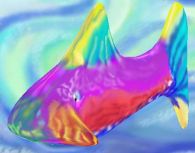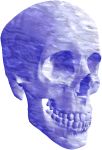Color and texture
Artists use color, intensity, and texture to draw attention to
specific areas of an image. Texture use is particularly interesting
because it is common for texture to be elided (or simplified)
depending upon the viewpoint, projected size, and the importance of
the object.
 I have developed two
systems for allowing the user to paint view-dependent texture directly
on the model. Both of these systems allow the user to pick particular
viewpoints and projection image-sizes, then paint onto the model. When
the object is rendered, the system blends between the appropriate
texture maps. Sort of Mip-mapping on steroids.
I have developed two
systems for allowing the user to paint view-dependent texture directly
on the model. Both of these systems allow the user to pick particular
viewpoints and projection image-sizes, then paint onto the model. When
the object is rendered, the system blends between the appropriate
texture maps. Sort of Mip-mapping on steroids.
 The primary
difference between the two systems is how the texture maps are
created. In the first, the object is already parameterized. In the
second, the projected object itself serves as a texture map
parameterization. This involves some cleverness with the depth map in
areas of occlusion.
The primary
difference between the two systems is how the texture maps are
created. In the first, the object is already parameterized. In the
second, the projected object itself serves as a texture map
parameterization. This involves some cleverness with the depth map in
areas of occlusion.
 We have also
automated this process, to some extent, by letting the user choose
both a texture and color for lighting the object. This is a
generalization of the Gooch warm-cool
rendering, extended to textures. The challenge here is how to smoothly
change between textures, both from shadowed to lit areas and as the
object moves. This paper presents both object-based (a-la the previous
papers) and image-based approaches.
We have also
automated this process, to some extent, by letting the user choose
both a texture and color for lighting the object. This is a
generalization of the Gooch warm-cool
rendering, extended to textures. The challenge here is how to smoothly
change between textures, both from shadowed to lit areas and as the
object moves. This paper presents both object-based (a-la the previous
papers) and image-based approaches.
 Artists often
combine abstraction with realism when rendering objects with a lot of
detail, such as trees. They outline the basic shape of the tree with a
shaded blob, then introduce detail where needed to create the illusion
of detail everywhere. This paper is a semi-automated approach of this
flavor - the user still has a great deal of control over the degree of
abstraction versus realism, and other rendering attributes.
Artists often
combine abstraction with realism when rendering objects with a lot of
detail, such as trees. They outline the basic shape of the tree with a
shaded blob, then introduce detail where needed to create the illusion
of detail everywhere. This paper is a semi-automated approach of this
flavor - the user still has a great deal of control over the degree of
abstraction versus realism, and other rendering attributes.
 Photographers
spend a great deal of time and effort creating good lighting,
especially for objects that have concavities and various material
types. In this paper, we capture the object under many different
lights, then employ a painting approach to re-light the object the way
we want. Joint work with Jack Tumblin and Bobby Bodenheimer.
Photographers
spend a great deal of time and effort creating good lighting,
especially for objects that have concavities and various material
types. In this paper, we capture the object under many different
lights, then employ a painting approach to re-light the object the way
we want. Joint work with Jack Tumblin and Bobby Bodenheimer.
We are continuing to look into the questions of image-editing
based on the human visual system.
Papers
- Lighting real-world objects using a painting interface.
- Composition. Each object in the scene has its own camera, color and light control.
- Shading using both texture and color.
- View-independent
texture maps. This is the first draft of the following paper, which
operated on manifold surfaces. Essentially, each "texture" map was
actually a set of texture maps parameterized by both view direction and object distance. (unpublished)
- A longer version of the above paper. (unpublished)
- Painting view-dependent texture maps. The painted images themselves are used as texture maps, with the camera projection creating the texture coordinates. (unpublished)
- Painting view-dependent textures, combines the above papers.
- Combining abstraction with realism, in this case, to render trees.
- View-dependent graftel textures. (unpublished)
- Color study to determine the effects of warm/cool colors on depth.
- Perceptually meaningful depth editing. Combines the color depth study with using spatial imprecision to give an illusion of motion.
Movies
- Sequence with no non-linear effects (OpenGL)
- Sequence with no non-linear effects (Radiance)
- Sequence with non-linear and color effects (OpenGL)
- Sequence with non-linear and color effects (Radiance)
- Rendering trees in a combination of abstraction and realism.
- Rendering trees with transparency.
- Rendering trees with slightly less transparency.
- Dark red texture applied to a model (3D texture painting).
- Dark red texture applied to a model (synthesized texture).
- Dark red texture applied to a model (view-dependent painting).
- Dark red texture applied to a model (Object-based).
Students
 I have developed two
systems for allowing the user to paint view-dependent texture directly
on the model. Both of these systems allow the user to pick particular
viewpoints and projection image-sizes, then paint onto the model. When
the object is rendered, the system blends between the appropriate
texture maps. Sort of Mip-mapping on steroids.
I have developed two
systems for allowing the user to paint view-dependent texture directly
on the model. Both of these systems allow the user to pick particular
viewpoints and projection image-sizes, then paint onto the model. When
the object is rendered, the system blends between the appropriate
texture maps. Sort of Mip-mapping on steroids.
 The primary
difference between the two systems is how the texture maps are
created. In the first, the object is already parameterized. In the
second, the projected object itself serves as a texture map
parameterization. This involves some cleverness with the depth map in
areas of occlusion.
The primary
difference between the two systems is how the texture maps are
created. In the first, the object is already parameterized. In the
second, the projected object itself serves as a texture map
parameterization. This involves some cleverness with the depth map in
areas of occlusion.
 We have also
automated this process, to some extent, by letting the user choose
both a texture and color for lighting the object. This is a
generalization of the Gooch
We have also
automated this process, to some extent, by letting the user choose
both a texture and color for lighting the object. This is a
generalization of the Gooch  Artists often
combine abstraction with realism when rendering objects with a lot of
detail, such as trees. They outline the basic shape of the tree with a
shaded blob, then introduce detail where needed to create the illusion
of detail everywhere. This paper is a semi-automated approach of this
flavor - the user still has a great deal of control over the degree of
abstraction versus realism, and other rendering attributes.
Artists often
combine abstraction with realism when rendering objects with a lot of
detail, such as trees. They outline the basic shape of the tree with a
shaded blob, then introduce detail where needed to create the illusion
of detail everywhere. This paper is a semi-automated approach of this
flavor - the user still has a great deal of control over the degree of
abstraction versus realism, and other rendering attributes.
 Photographers
spend a great deal of time and effort creating good lighting,
especially for objects that have concavities and various material
types. In this paper, we capture the object under many different
lights, then employ a painting approach to re-light the object the way
we want. Joint work with
Photographers
spend a great deal of time and effort creating good lighting,
especially for objects that have concavities and various material
types. In this paper, we capture the object under many different
lights, then employ a painting approach to re-light the object the way
we want. Joint work with